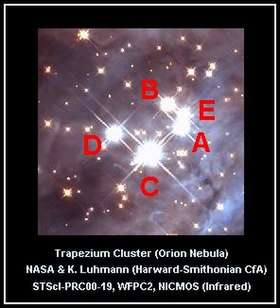Theta1 Orionis C
| Observation data Epoch J2000 Equinox J2000 | ||
|---|---|---|
| Constellation | Orion | |
| Right ascension | 05h 35m 16.46375s[1] | |
| Declination | −05° 23′ 22.8486″[1] | |
| Apparent magnitude (V) | 5.13[2] | |
| Characteristics | ||
| Spectral type | θ1 Orionis C1: O6Vp[3] θ1 Orionis C2: B0V[4] | |
| U−B color index | −0.95[2] | |
| B−V color index | +0.02[2] | |
| Variable type | suspected[5] | |
| Absolute magnitude (MV) | −4.9[8] | |
| Details | ||
| C1 | ||
Myr | ||
| C2 | ||
| Mass | 11 ± 5[4] M☉ | |
Argument of periastron (ω)(secondary) | 290.9 ± 2.5° | |
BD –05° 1315C | ||
| Database references | ||
| SIMBAD | data | |
Theta1 Orionis C (θ1 Orionis C) is a member of the
Theta1 Orionis consists of multiple components, primarily the four stars of the Trapezium cluster, all within one arc-minute of each other. Theta2 Orionis is a more distant grouping of three main stars plus several fainter companions, 1-2 arc-minutes from Theta1.
Theta1 C is itself a binary of two massive stars, C1 and C2, plus a very close fainter companion apparently escaping the system.[9]
Theta1 Orionis C1 is responsible for generating most of the ultraviolet light that is slowly ionizing (and perhaps photoevaporating) the Orion Nebula. This UV light is also the primary cause of the glow that illuminates the Orion Nebula. The star emits a powerful stellar wind that is a hundred thousand times stronger than the Sun's, and the outpouring gas moves at 1,000 km/s.
References
- ^ S2CID 18759600
- ^ Bibcode:2002yCat.2237....0D.
- ^ "Science Source Stock Video - Trapezium C1 main sequence star, animation".
- ^ S2CID 120838635.
- Bibcode:2009yCat....102025S.
- S2CID 119110490.
- ^ S2CID 14555075.
- ^ S2CID 16445304.
- S2CID 123527966.

